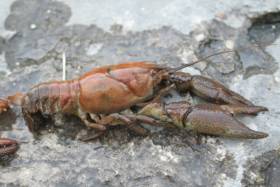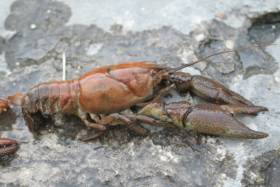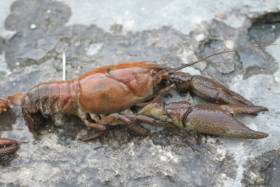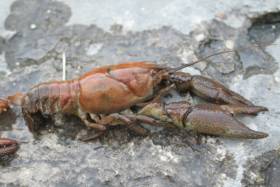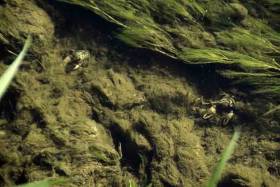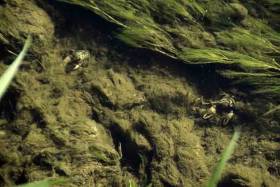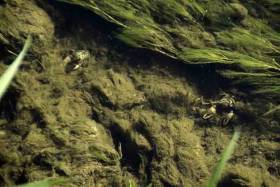Displaying items by tag: Crayfish
Young Scientist Completes Study on Conservation of White-Clawed Crayfish With Marine Institute
Young student scientist Juliette Ó Súilleabháin recently completed a project studying the conservation of white-clawed crayfish with the support of the Marine Institute.
Juliette — a second-year student in St Mary’s Secondary School Mallow — approached the institute’s Marine Environment and Food Safety Services team about her individual project: Assessing the Presence of White-Clawed Crayfish (Austropotamobius pallipes) in the Blackwater catchment area of Mallow using Environmental DNA Analysis and the identification of possible Ark Sites.
The student accompanied staff on fieldwork so she could learn non-invasive sampling techniques for this protected species. Subsequently, she visited the labs and learned how to extract DNA and run PCRs.
Her project has since qualified in the Biological & Ecological category for the BT Young Scientist and Technology Exhibition, which opens to visitors from Thursday 11 January at Dublin’s RDS.
Juliette explained how her project came about: “I wanted to do a Young Scientist project on an ecological topic and contacted some ecologists for guidance. My original project involved the investigation of the presence and distribution of white-clawed crayfish (WCC) on the stretch of the Blackwater River where I live. A very recent crayfish plague outbreak in the Blackwater Catchment decimated the catchment’s crayfish population and put an end to my project.
“After further consultation, I chose the identification of potential WCC conservation ark sites as an alternative project topic. From my research, I learned about environmental DNA (eDNA) and the National Surveillance Programme for Crayfish Plague. I thought eDNA would be a useful tool in screening ark sites, so I contacted Bogna Griffin of the Marine Institute, and she kindly allowed me to accompany her on an eDNA sampling field trip to the Blackwater Catchment, and subsequently invited me to conduct eDNA laboratory work for my project in the Marine Institute in Oranmore, Co Galway.
“A massive thank-you to Bogna and the Marine Institute for giving me such a wonderful experience of a fascinating science topic!”
Supervising scientist Bogna Griffin said: “I was very impressed with [Juliette’s] attitude, the level of her write-up, and the depth of her knowledge in ecology and molecular biology. We are all very proud of her in the Fish Health Unit and wish her and all students the best of luck in January at the exhibition.”
Staff from the Marine Institute will be on hand as part of the Department of Agriculture, Food and the Marine’s Labs exhibit at the 2024 BT Young Scientist and Technology Exhibition, which runs until Saturday 13 January. Tickets are available HERE.
Invasive Crayfish's Ability to Adapt to Cold Water Environments Identified By Japanese Scientists
Molecular mechanisms that allowed a type of tropical crayfish to become a global invasive species by adapting to colder water have been identified by scientists in Japan.
The research is relevant to growing concerns about animal species colonising new habitats across the globe, with devastating impacts on local biodiversity.
A paper published in the journal iScience explains that recently discovered genes may help the red swamp crayfish to produce protective proteins which allow them to adapt to the cold.
The red swamp crayfish—known to the scientific world as Procambarus clarkii (P. clarkii)— is a freshwater species native to the tropical regions of southern USA and northeastern Mexico.
These particular crayfish have become one of the most widespread and invasive animal species, the researchers note.
They are known for their “adaptability and aggressive behaviour that ensure their survival in a wide range of environments, even in regions much colder than their original habitats”.
A group of researchers from Japan, including Dr Daiki Sato, assistant professor at the Graduate School of Science of Chiba University, and Professor Takashi Makino from Tohoku University focused on crayfish settling Sapporo city in central Hokkaido, where water temperatures are extremely low during the winter.
They sought to study the genetic changes that have allowed the crayfish to adapt to these cold environments.
“A population of red swamp crayfish in Sapporo, Japan may have acquired genetic changes that enhanced its cold tolerance. We have revealed the genes and genomic architecture possibly involved in the cold adaptation mechanism,”Dr Sato said.
“Although the red swamp crayfish has been a well-known and notorious invasive species in Japan for quite some time, nobody has examined its genomic and transcriptomic characteristics that contribute to its invasiveness yet, thus motivating us to pursue this study,” Prof Makino, who led the study, said.
“We feel our study has far-reaching ecological implications,” he said.
“Overall, these findings significantly contribute to our understanding of invasive species, which may help us take measures to prevent their spread and, in turn, protect global biodiversity,” the researchers said.
Their study was made available online on July 3rd, 2023, and will be published in Volume 26, Issue 8 of the journal iScience on August 18, 2023.
Public Consultation Launched on Future Fishery Management of Critically Endangered Crayfish
A public consultation is now under way in respect of the future management of the crayfish fishery to protect critically endangered species.
The purpose of this consultation is to seek the views of those with an interest in the future of the crayfish fishery off the South West Coast of Ireland.
The information received during the consultation will inform policy decisions, including the development of sustainable conservation measures for the crayfish fishery inside 12 nautical miles between Mizen Head and Loop Head.
The objective of these is to identify measures targeted at eliminating the by-catch of endangered species in this crayfish fishery and securing a viable and sustainable future for the fishery itself.
Submissions can be made online (except Internet Explorer). Alternative, you can download and complete the Consultation Submission Document and return it by email to [email protected] (with the subject line “Crayfish Consultation”) or by post to:
Crayfish Consultation
Marine Programmes Division
Department of Agriculture, Food and the Marine
National Seafood Centre
Clonakilty, Co Cork
P85 TX47
The closing date for responses is close of business on Thursday 16 September.
Third Crayfish Plague Case Of 2019 Confirmed in River Nore
Crayfish plague has been confirmed in the River Nore in Co Kilkenny, marking the eighth record in Irish rivers since 2015 — and the third detected this year alone, as TheJournal.ie reports.
Outbreaks of crayfish plague pose a significant threat to the survival of Ireland’s native white-clawed crayfish, according to the National Parks and Wildlife Service (NPWS).
Ahead of a seminar on the response to recent outbreaks earlier this summer, the NPWS appealed to all water users to take responsible action and follow guidelines under the ‘Check-Clean-Dry’ protocols.
That followed news of crayfish plague in the River Maigue near Adare in Co Limerick, which is now predicted to lose its population white-clawed crayfish, a globally endangered aquatic species.
The NPWS also revealed that non-native crayfish have been identified in the wild in Ireland for the first time, at a location not disclosed.
Brian Nelson of the NPWS said: “The discovery of the non-native crayfish species in the wild is of concern as this has never been found before in Ireland.
“Although the species is one we would not have predicted, it presents us with a greater challenge of eradicating the species.”
The keeping and importing of mon-native crayfish is now illegal, and anyone with specimens should contact the NPWS.
Galway Hosts Irish Crayfish Seminar Next Month
The Marine Institute in Oranmore, Co Galway will host an Irish Crayfish Seminar on Tuesday 21 and Wednesday 22 May in response to recent outbreaks of crayfish plague in Ireland’s waterways.
A series of talks by invited speakers from across Ireland and Europe will cover many aspects of crayfish ecology and what is known about the disease.
The latest international and national research findings will be presented on the broad topics of:
- Irish crayfish in national, all Ireland and European contexts.
- Ecology of white-clawed crayfish in Ireland.
- Crayfish plague: What is it? How did it get here? What can we do about it?
- Crayfish plague in Europe: What can we learn from the European experience?
- Biosecurity: its importance and practical advice on safe, clean working.
The event is free but booking is essential. Resigter online before 5pm on Monday 13 May.
An outline of the two-day seminar with confirmed speakers is available to read or download HERE.
Water Users Called On To Help Limit Crayfish Plague Outbreak In Athlone
All water users along the River Shannon are being urged to take precautions after confirmation of an outbreak of crayfishrayfish plague on a stretch of the Al River.
This river is one of the main tributaries to the River Shannon in Athlone and flows westerly, entering the Shannon downstream of the weir.
A small number of dead freshwater crayfish were reported on the river last week. DNA analysis by the Marine Institute has now confirmed that crayfish were infected with the fungus-like organism responsible for causing crayfish plague.
Further analysis is still ongoing to establish if there may be any links between this and previous outbreaks of crayfish plague.
Crayfish plague only impacts native white-clawed crayfish. Fish and other freshwater animals are not affected.
The disease infects species of crayfish and experience elsewhere indicates the disease can cause up to 100% mortality in white-clawed crayfish species.
Agencies including the National Parks and Wildlife Service, Westmeath Municipal and County Councils will be working together to erect signage along the Al River and information will be on the Westmeath County Council website.
Crayfish plague is recognised as a very significant threat to the survival of the globally threatened white-clawed crayfish in Ireland.
The disease is considered fatal to all infected native crayfish and the experience in other countries is that where outbreaks occur there is complete extermination of white-clawed crayfish populations. It is spread invisibly in water and the infectious stage may be moved to other river and lake systems on equipment, boats and machinery.
The crayfish plague comes from the North American species of crayfish, which are now widespread in the UK and on the continent of Europe. To date there are no known records of these American species in Ireland and it is against the law to bring them into Ireland, to sell them, distribute them or release them.
This is the seventh confirmed outbreak of the disease in the whole of Ireland since it was first found in 2015 in Co Cavan, followed by four separate confirmed outbreaks in 2017 and one confirmed outbreak in Northern Ireland earlier this year.
The closest known previous outbreak to this was one in the Lorrha in Co Tipperary and it is not known how the disease could have spread to the River Al at this time.
Anyone involved in activities in the Al River and River Shannon should observe the ‘Check, Clean and Dry’ protocol once they leave the river and before visiting any waterway again. This includes community and local authority clean-up groups, survey work, as well as anglers and all recreational water uses.
All wet gear (boats, clothing and equipment) should be checked for any silt or mud, plant material or animals before being thoroughly cleaned and finally dried.
Disinfectant or hot water (over 40 degrees Celsius) should be used to clean all equipment and this should be followed by a minimum 48-hour drying period (preferably longer, up to a week).
Members of the public will see any dead or dying crayfish should report this to National Parks and Wildlife Service, Westmeath County Council, or Colette O’Flynn at the National Biodiversity Data Centre, Waterford at [email protected].
Anyone who suspects they have seen a non-native species of crayfish are asked to take a picture of it showing the underside of the claws and submit via the National Biodiversity Data Centre’s invasive species record form or direct to Colette O’Flynn.
Fisheries Body Welcomes New Legislation To Help Protect Native White-Clawed Crayfish
#Crayfish - Inland Fisheries Ireland (IFI) says it welcomes new legislation to strengthen existing measures to protect the native white-clawed crayfish.
The European Union (Invasive Alien Species) (Freshwater Crayfish) Regulations 2018 will provide Irish authorities with powers to prevent the arrival and spread of five non-native species of crayfish included on the EU List of Invasive Alien Species of Union concern.
Ireland holds one of the largest surviving populations of the globally threatened white-clawed crayfish, a freshwater species protected under Irish law and the EU Habitats Directive.
The species has been decimated throughout Europe by the impact of crayfish plague — and many North American crayfish species are believes to be vectors for the disease.
While there is no evidence that any non-native crayfish have been introduced to Ireland, crayfish plague has now reached five rivers in Ireland, possibly by spores carried on angling equipment.
IFI says the prospect of the disease being controlled depends on the absence of non-native crayfish.
“We welcome this new legislation which is needed if we are to resist the threat from introduced crayfish,” says IFI chief executive Dr Ciaran Byrne.
“If invasive alien crayfish were to be introduced in Ireland, this could have a devastating effect on the ecology of many of the lakes and rivers.
“We would urge the public to comply with the new regulations and help protect our native crayfish species. In particular, we would remind anglers to maintain vigilance in relation to the crayfish plague by carrying out routine cleaning and drying of equipment once leaving a river and before using it again.”
Sightings of unusual crayfish (eg red claws, large size) or any mass mortalities of crayfish can ve reported to the relevant authorities by contacting the National Parks and Wildlife Service, the National Biodiversity Data Centre or Inland Fisheries Ireland.
Suspected Outbreak Of Crayfish Plague In Lough Owel
#Crayfish - The National Parks and Wildlife Service (NPWS) is investigating the widespread deaths of white-clawed crayfish in Lough Owel that may be linked to an outbreak of crayfish plague.
As TheJournal.ie reports, the Co Westmeath inland waterway is home to a large population of the endangered marine species, which have never before tested positive for the plague.
Samples are being tested by the Marine Institute’s Fish Health Unit — which recently investigated an outbreak of carp edema virus in Cork — with the first results due in days.
The most recent outbreak of crayfish plague was last Autumn in the River Barrow, following incidents in North Tipperary. Ireland was considered free of the disease before 2015.
TheJournal.ie has more on the story HERE.
Crayfish Plague Spreads To River Barrow
#Crayfish - Large numbers of dead freshwater crayfish have been reported in the River Barrow in the stretch from Carlow to Graiguemanagh.
It has been confirmed using DNA analysis that the cause of death was crayfish plague.
This is the fifth outbreak of the disease to be found in Ireland in the last two years, and follows just weeks after an outbreak in North Tipperary.
It is feared that if the disease spreads further, then it will threaten the survival of the entire Irish population of white-clawed crayfish, an endangered marine species.
This worrying situation is being investigated by the National Parks and Wildlife Service of the Department of Culture, Heritage and the Gaeltacht, Inland Fisheries Ireland and the Marine Institute.
All the agencies involved in managing and protecting the rivers in Ireland are concerned that another outbreak has been detected, and are reiterating their advice and guidance to all users of the river to implement routine cleaning and drying of their equipment once they leave the river and before using it again.
This is especially important as it is known that the crayfish plague organism can be carried on wet equipment to new sites. Containment of the outbreak is essential to prevent spread to other as yet unaffected populations in Ireland.
Waterways Ireland, which manages the Barrow navigation, has issued a marine notice calling all recreational, commercial, private and public body water users (boaters, walkers, swimmers, kayakers, rowers, machine operators, etc) to operate a temporary ban on moving watersport and angling equipment and other equipment or machinery that comes in contact with the water, out of or into the Barrow and all affected catchments.
People are also asked to alert the authorities of any mass mortality of crayfish or sightings of unusual crayfish that might be non-native species (such as crayfish with red claws, or of an unusually large size).
Warning Over Crayfish Plague Outbreak In North Tipperary
#Crayfish - All water users are being urged to take precautions to stop the spread of crayfish plague after confirmation of an outbreak on the Lorrha River in North Tipperary, close to Lough Derg and the River Shannon.
Numbers of dead freshwater crayfish were reported on the river in Lorrha village earlier this month, and DNA analysis has now confirmed that the cause of death was crayfish plague.
This is the fourth confirmed outbreak of crayfish plague since 2015, with earlier outbreaks affected the Bruskey/Erne River in Co Cavan, the River Suir downstream of Clonmel and the River Deel downstream of Newcastle West.
The situation is being investigated by the National Parks and Wildlife Service (NPWS) of the Department of Culture, Heritage and the Gaeltacht, Inland Fisheries Ireland (IFI), the Marine Institute, and Tipperary County Council.
The kill has impacted white-clawed crayfish only. Other freshwater animals are not affected. This is a characteristic feature of the disease which only infects species of crayfish but causes 100% mortality.
There is no indication at this stage of how the disease reached the Lorrha River. It is however known that the outbreak on the Suir involved a different strain of the disease to that in the Cavan outbreak.
Samples from the Lorrha River are being tested to determine which strain has caused the outbreak of the disease.
All agencies involved in managing and protecting the rivers in Ireland have expressed concern that another outbreak has been detected, and are reiterating their advice and guidance to all users of the river to implement routine cleaning and drying of their equipment once they leave the river and before using it again.
This is especially important as it is known that the crayfish plague organism can be carried on wet equipment to new sites. Containment of the outbreak is essential to prevent spread to other as yet unaffected populations in Ireland.
Anyone using the river is being urged to observe the Check, Clean and Dry protocol. All wet gear should be checked for any silt or mud, plant material or animals. It then should be cleaned and finally dried. Disinfectant or hot water (over 60C) should be used to clean all equipment followed by a 24-hour drying period. This should be adopted as standard practice in all freshwaters.
Drying is especially important, including removing of any water from inside a boat and disposing of it on grass. A drying period of at least 24 hours is needed to ensure that a boat is clear of infectious organisms.
Furthermore, all water users are asked to operate a temporary ban on moving watersport and angling equipment out of the River Suir and River Deel catchments, commencing immediately.
Watersport and angling equipment currently in use in the Suir and Deel catchments may continue to be used there, but boats, angling or water sports equipment should not be transferred in or out of the catchments.
Users are requested to limit their activity to the river sections where they normally operate, and avoid moving around the catchment. More advice is available from Biodiversity Ireland.
People are also asked to alert the authorities of any mass mortality of crayfish or sightings of unusual crayfish that might be non-native species (eg crayfish with red claws, large size).
The white-clawed crayfish is a globally threatened species and Ireland holds one of the largest surviving populations. It is the only freshwater crayfish species found in Ireland and is present in lakes, rivers and streams over much of the island.
Throughout its European range, this species has been decimated by the impact of crayfish plague, which spread to Europe with the introduction of North American species of crayfish. Until 2015, Ireland was considered free of the disease and it remains the only European country without any established non-native crayfish species.
Many American crayfish species are resistant to crayfish plague, but can act as carriers of the disease, which is rapidly fatal when passed to the white-clawed crayfish.
The combined impact of the introduced crayfish species (which may out-compete the smaller native crayfish) and crayfish plague have completely eliminated the white-clawed Crayfish from much of its European range, leaving Ireland as the last stronghold of the species.
The species is protected under Irish Law and the EU Habitats Directive. It is illegal to deliberately release any non-native species of crayfish into Irish freshwaters.
If crayfish plague becomes established, there is a high probability that the white-clawed crayfish will be eliminated from much of the island. What’s more, if non-native crayfish are found to be established in Ireland, this could have a severe impact on habitats (eg destabilising canal and river banks by burrowing) and other freshwater species, such as salmon and trout fisheries.
However, there is no evidence to date that non-native freshwater crayfish have been introduced to Ireland.


























